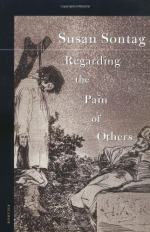
|
| Name: _________________________ | Period: ___________________ |
This quiz consists of 5 multiple choice and 5 short answer questions through Chapter 8.
Multiple Choice Questions
1. Which Virginia Woolf book does Sontag discuss in detail?
(a) The Hours.
(b) Three Guineas.
(c) Orlando.
(d) Mrs. Dalloway.
2. Fenton received directions from the War Office to do which of the following?
(a) Generate propaganda for Britain.
(b) Avoid photographing the ill, wounded, dying and dead.
(c) Glorify war through patriotic images.
(d) Graphically depict the horrors of war.
3. Which of the following magazines was NOT devoted entirely to photography?
(a) Life.
(b) Vu.
(c) National Geographic.
(d) Picture Post.
4. Sontag claims that some photographs which are "repulsive" can also ________.
(a) Impress.
(b) Allure.
(c) Silence.
(d) Shock.
5. Sarajevans were angered by a photography exhibit which featured photographs of their suffering alongside images of which other country's people?
(a) Bulgaria.
(b) Rhodesia.
(c) Bosnia.
(d) Somalia.
Short Answer Questions
1. Underneath feelings of apathy, Sontag contends are which of the following feelings?
2. According to Sontag, war journalism first developed during which of the following two wars?
3. Sontag argues that technological advances changed the way the public understands war by:
4. After World War I, the general public thought of the War as:
5. Sontag argues that there are two extreme positions on a spectrum of war experience which create the same idea that images of war are no longer emotionally-jarring for an audience? Which two positions are they?
|
This section contains 316 words (approx. 2 pages at 300 words per page) |

|




